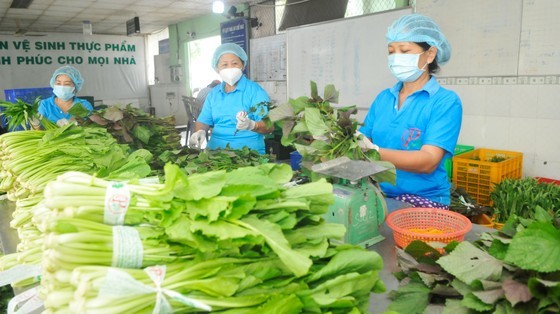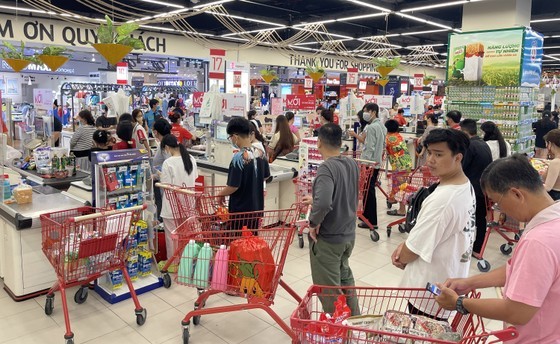 |
Vegetable processing at Phuoc An Cooperative, Binh Chanh District, HCMC. Photo by Cao Thang/ SGGP |
In particular, from May onwards, indexes of industrial production, total retail sales, and total foreign investment capital all grew positively.
Growth recovery
According to the HCMC Statistics Office, the city's economy in the first 9 months of 2023 recorded some bright spots. To be more specific, the index of industrial production (IIP) reported a year-over-year increase of 3.2 percent, with corresponding increases in the first, second, and third quarters being 5 percent, 7.7 percent and 12.9 percent, respectively.
Similarly, total retail sales of goods and service reached US$35.76 billion (VND871,198 billion), a year-over-year increase of 8.6 percent, compared to the growth to 0.9 percent, 4.0 percent and 6.2 percent in the first, second, and third quarters, respectively.
Regarding attracting direct foreign investment, the city has licensed 860 new projects, a growth of 51.7 percent, while the registered capital has reached $406.1 million, an increase of 16.7 percent compared to last year. Another bright spot lies in the city's digital transformation activities. According to the Ministry of Information and Communications, HCMC ranks second in the country in terms of digital transformation index in 2022 when the digital economy occupied 18.66 percent in the city's GRDP.
According to Mr. Nguyen Anh Duc, Chairman of the Vietnam Retailers Association, from July to September 2023, the domestic retail industry has shown positive signs of recovery, reaching a growth rate of over 7 percent compared to last year. Particularly in HCMC, the total retail sales are very impressive in the context of the sharp fall in the world's aggregate demand.
In fact, some positive impacts have been reaped thanks to the demand-stimulating policies, including reducing value added tax by 2 percent, extending tax payment time, reducing land use taxes and fees, boosting large-scale promotion programs, developing tourist visa policy, and reducing lending interest rates.
From another perspective, a representative of Centrail Retail Group said that Vietnam in general and HCMC in particular are considered strategic destinations in the global supply chain, chosen by many foreign businesses. Given their remarkable transformation, Vietnam’s businesses have lifted the country into a major global production center with great supply capacity in terms of diverse products, competitive prices, and improved quality.
Expanding room for development
 |
Customers waiting to pay at Lotte Mart supermarket District 7, HCMC. Photo by Hoang Hung/ SGGP |
From the above actual records, the HCMC Development Research Institute has forecast three levels of economic growth for the city in 2023, at 6.08 percent, 6.47 percent and 7.46 percent. In order to achieve the highest estimated rate of 7.46 percent, the political system of HCMC should effectively and synchronously deploy many solutions to expand the room for development.
Accordingly, first, it is advisable to effectively deploy breakthrough policies proposed in Resolution 98/2023, which was passed in the 15th National Assembly, on piloting a number of specific mechanisms and policies for the development of HCMC.
Secondly, the progress of adjusting HCMC's general planning to 2040 with a vision to 2060 needs to be accelerated; at the same time, develop a socio-economic master plan for HCMC for the period 2021-2030, with a vision to 2050. Thirdly, the city should continue to promote public investment disbursement. Fourthly, domestic consumption should be stimulated. Fifthly, More efforts should be made to improve the investment environment to restore business confidence. Sixthly, the city authorities should take social welfare into careful consideration. Seventhly, the green economy and digital transformation should be leverages for the city's economic growth.
Over $143.8 million allocated for urgent projects
The HCMC People's Council recently passed a resolution on additional adjustments to the medium-term public investment plan for the period 2021-2025 from local budget capital.
Accordingly, HCMC shall spend more than $143.8 million (VND3,500 billion) on urgent projects serving socio-economic development, addressing social welfare needs for Thu Duc City and 5 districts. Of these $61 million (VND1,485 billion) will be spent on 28 projects in Thu Duc City, $19,071 million (VND464 billion) for Nha Be District, $9,126 million (VND222 billion) for Hoc Mon District, $22,486 million (VND547 billion) for Binh Chanh District, $17,882 million (VND435 billion) for Cu Chi District, and $15,703 million (VND382 billion) for Can Gio District.
Mr. Truong Minh Huy Vu, Deputy Director of the HCMC Institute for Development Research, emphasized that in order to effectively implement the economic development policy, first, the city needs to promote a stronger sense of responsibility and eradicate the "fear of making mistakes" among a section of officials and leaders, promoting stronger decentralization to local levels.
On the other hand, it is necessary to quickly restart the International Financial Center Project to increase internal capital resources for the economy. In the field of attracting foreign investment, authorities should develop and research a new set of criteria and procedures for exclusively selecting strategic investors in core sectors, including the developments of innovation centers, research and development centers, clean energy industry, Can Gio international transit port, and chip-semiconductor production.
Besides, there should be additional support policies consistent with the global minimum tax convention. There also need to be policies to support businesses in green transformation and pilot application in a number of key industries.
Meanwhile, according to Mr. Nguyen Anh Duc, businesses need to proactively capture market information, as well as identify target markets and customers, thereby focusing on researching and developing suitable products for each market, with a systematic production and export plan to meet the requirements of distributors involved in the supply chain.
At the same time, businesses need to urgently develop plans to obey sustainability criteria, which requires green production, transparency and traceability standards throughout the entire value chain, technological innovation, digital application, modern machinery investment, and smart production aiming for green, clean, circular production criteria. In addition, businesses need to focus on building and promoting brand identity, which will provide them with a competitive advantage in the global market.
- Mr. Nguyen Ngoc Hoa, Chairman of HCMC Business Association:
Improved access to capital
The good news for the businesses in HCMC is that the HCMC People's Council has approved a resolution promulgating regulations on interest rate support for investment projects that belong to priority areas for socio-economic development in the city and successfully requested loans from the HCMC State Financial Investment Company (HFIC).
However, to support businesses in maintaining a stable growth recovery, the State Bank of Vietnam and commercial banks need to encourage more capital injected into the economy by simplifying loan procedures and conditions, signing cooperation agreements between banks and district-level People's Committees, as well as reducing loan mortgage conditions.
Furthermore, departments and agencies should also simplify administrative procedures, and quickly resolve urgent and legitimate requests of businesses such as value-added tax refunds, investment procedures, construction licensing, land use rights granting, and work permits.
- Mr. Pham Binh An, Deputy Director of HCMC Institute for Development Studies:
Bright spots in global supply chain
HCMC is becoming an attractive destination for many global supply chains, especially the supply of supporting industrial products. Since the beginning of the year, the city has welcomed many foreign corporations in search for product supplies from Vietnamese businesses, which has opened up many export opportunities.
Therefore, the city needs to organize more domestic and foreign trade promotion activities to increase access to export orders among businesses. On the other hand, it is necessary to focus on organizing many activities to stimulate domestic consumption through promotion programs, market stabilization activities to drive purchasing power for the domestic market, thereby spreading growth motivation for other related fields.
























